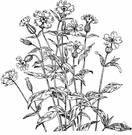This approach has been employed to develop several gender-linked molecular markers in dioecious plants, including
Silene latifolia [19], Pistacia vera [20], Cannabis sativa [21], Humulus lupulus [22], Actinidia chinensis [23], Atriplex garrettii [24], Carica papaya [25], Salix viminalis [26], Rumex acetosa [27], Mercurialis annua [28], and Eucommia ulmoides [29].
by Dobson, 2006), including
Silene latifolia (Caryophyllaceae; Dotterl and Jurgens, 2005) and Platanthera bifolia (Orchidaceae; Plepys et al., 2002) and suspected for the food-deceptive Phlox relative, Linanthus dichotomus (Polemoniaceae; Chess et al., 2008).
Importance of Floral Scent Compounds for the Interaction between
Silene latifolia (Caryophyllaceae) and the Nursery Pollinator Hadena bicruris (Lepidoptera: Noctuidae).
Tabla 1 Poblaciones analizadas y material usado para el estudio morfometrico en la seccion Elisanthe del genero Silene Taxa Localidad Silene dioica Poblacion 1 Espana: Leon, Puerto de las Senales Poblacion 2 Espana: Asturias, Puerto de Tarna
Silene latifolia Poblacion 1 Espana: Salamanca, Linares de Riofrio, Las Honfrias Poblacion 2 Espana: Salamanca, El Cabaco Poblacion 3 Espana: Salamanca, Robleda Silene marizii Poblacion 1 Portugal: Beira Alta, Guarda, Sabugal Poblacion 2 Portugal: Beira Alta, Mangualde Poblacion 3 Portugal: Beira Alta, Caramulo Poblacion 4 Espana: Salamanca.
tristis (prairie -- -- 2.5 willow) * Saponaria officinalis (bouncing bet) -- -- 2.5 Scirpus atrovirens (dark-green 2.5 -- -- bulrush) * Scirpus pendulus (rufous bulrush) * 2.5 -- -- Setaria glauca (yellow foxtail) -- 2.5 2.5 Setaria viridis (green foxtail) -- -- 2.5
Silene latifolia (white campion) -- 2.5 2.5 Silene vulgaris (bladder campion) * -- -- 2.5 Smilacina racemosa (false spikenard) * -- -- -- Smilax hispida (bristly greenbrier) * -- -- -- Smilax rotundifolia (common -- -- -- greenbrier) * Solanum carolinense (horsenettle) 2.5 2.5 -- Solidago canadensis var.
Flow cytometry has also been used for analysis of DNA base-pair composition, including measuring quantitative differences between genomes of male and female individuals of the dioecious
Silene latifolia (P.
A size-number trade-off is also apparent in the dioecious herb
Silene latifolia, as females produce fewer, but larger, flowers than males.
Silene latifolia (white campion) is dioecious, with separate male and female individuals.
Previous work on pollinator attraction and floral traits for hosts affected by anther smut has focused on three species,
Silene latifolia (=Silene alba) (Alexander 1987, 1989, 1990, Shykoff and Bucheli 1995), Silene dioica (Hassan and MacDonald 1971, Lee 1981, Elmqvist et al.
An earlier paper in this series documented genetic variation for several sexually dimorphic traits in
Silene latifolia (Meagher 1992).
The data to be used in our examples are the location, disease status, and gender of 245 individual plants [ILLUSTRATION FOR FIGURE 1 OMITTED] from a natural population of
Silene latifolia infected with an anther smut, Microbotryum violaceum (Alexander and Antonovics 1988).
In the present study, we examine the relationship between timing and amount of allocation to reproduction and overall resource allocation in the dioecious plant
Silene latifolia (synonymous with S.
 Silene latifolia - bluish-green herb having sticky stems and clusters of large evening-opening white flowers with much-inflated calyx; sometimes placed in genus Lychnis
Silene latifolia - bluish-green herb having sticky stems and clusters of large evening-opening white flowers with much-inflated calyx; sometimes placed in genus Lychnis